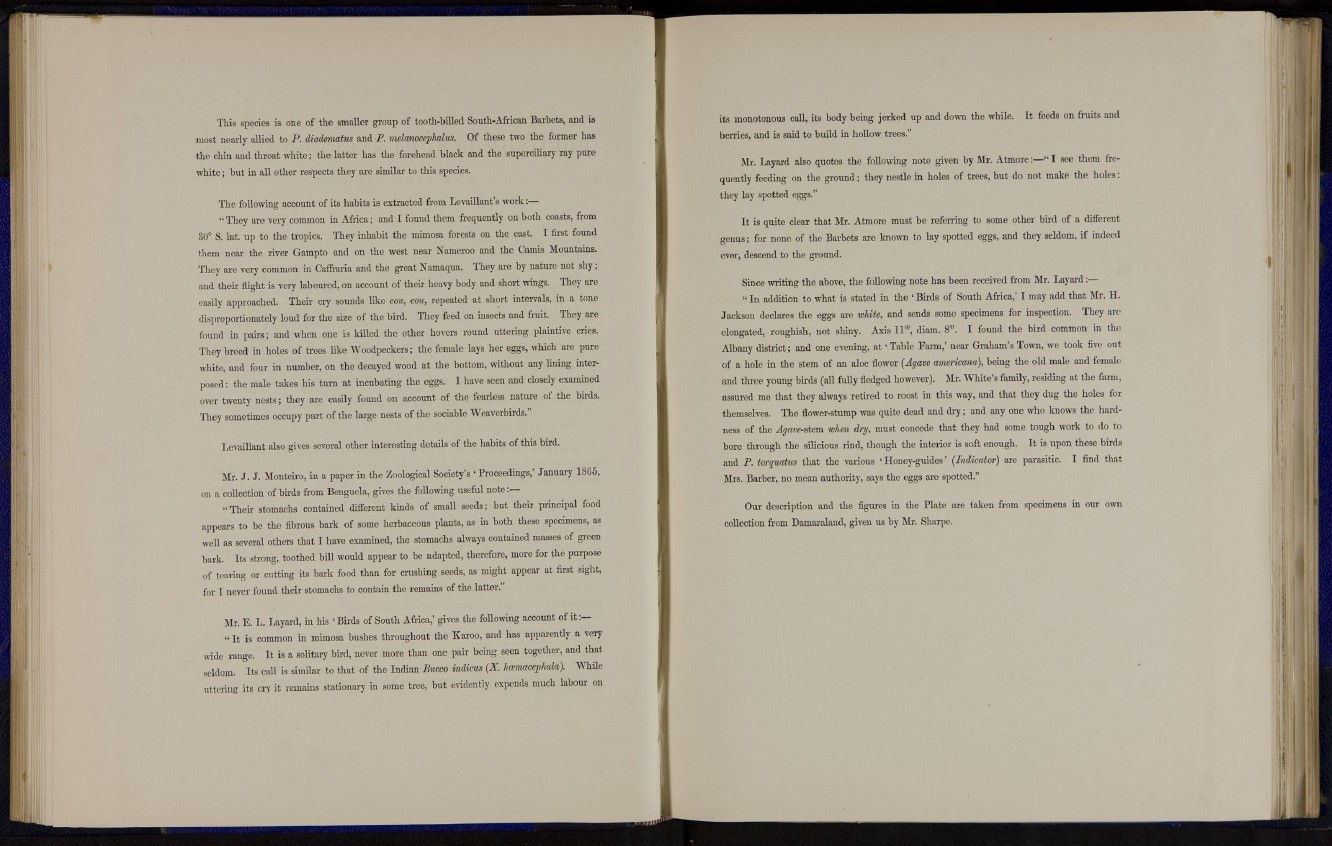
This species is one of the smaller group of tooth-billed South-African Barbets, and is
most nearly allied to P. diadematus and P. melanocephalus. Of these two the former has
the chin and throat white; the latter has the forehead black and the superciliary ray pure
white; but in all other respects they are similar to this species.
The following account of its habits is extracted from Levaillant's work:—
" They are very common in Africa; and I found them frequently on both coasts, from
3(J° S. lat. up to the tropics. They inhabit the mimosa forests on the east. I first found
them near the river Gampto and on the west near Namcroo and the Camis Mountains.
They are very common in Caffraria and the great Namaqua. They are by nature not shy;
and their flight is very laboured, on account of their heavy body and short wings. They are
easily approached. Their cry sounds like cou, con, repeated at short intervals, in a tone
disproportionately loud for the size of the bird. They feed on insects and fruit. They are
found in pairs; and when one is killed the other hovers round uttering plaintive cries.
They breed in holes of trees like Woodpeckers; the female lays her eggs, which are pure
white, and four in number, on the decayed wood at the bottom, without any lining interposed
: the male takes his turn at incubating the eggs. I have seen and closely examined
over twenty nests; they are easily found on account of the fearless nature of the birds.
They sometimes occupy part of the large nests of the sociable Weaverbirds."
Levaillant also gives several other interesting details of the habits of this bird.
Mr. J. J. Monteiro, in a paper in the Zoological Society's ' Proceedings,' January 18G5,
on a collection of birds from Benguela, gives the following useful n o t e :—
" T h e i r stomachs contained different kinds of small seeds; but their principal food
appears to be the fibrous bark of some herbaceous plants, as in both these specimens, as
well as several others that I have examined, the stomachs always contained masses of green
bark. Its strong, toothed bill would appear to be adapted, therefore, more for the purpose
of tearing or cutting its bark food than for crushing seeds, as might appear at first sight,
for I never found their stomachs to contain the remains of the latter."
Mr. E. L. Layard, in his ' Birds of South Africa,' gives t h e following account of i t :—
" I t is common in mimosa bushes throughout the Karoo, and has apparently a very
wide range. It is a solitary bird, never more than one pair being seen together, and that
seldom. Its call is similar to that of the Indian Bucco indicus (X. hovmacephala). While
uttering its cry it remains stationary in some tree, but evidently expends much labour on
its monotonous call, its body being jerked up and down the while. It feeds on fruits and
berries, and is said to build in hollow trees."
Mr. Layard also quotes the following note given by Mr. Atmore:—" I see them frequently
feeding on the ground; they nestle in holes of trees, but do not make the holes:
they lay spotted eggs."
I t is quite clear that Mr. Atmore must be referring to some other bird of a different
genus; for none of the Barbets are known to lay spotted eggs, and they seldom, if indeed
ever, descend t o t h e ground.
Since writing the above, the following note has been received from Mr. Layard:—
" I n addition to what is stated in the ' Birds of South Africa,' I may add t h a t Mr. H.
Jackson declares the eggs are white, and sends some specimens for inspection. They are
elongated, roughish, not shiny. Axis 11"', diam. 8"'. I found the bird common in the
Albany district; and one evening, at 'Table Farm,' near Graham's Town, we took five out
of a hole in the stem of an aloe flower (Agave americana), being the old male and female
and three young birds (all fully fledged however). Mr. W h i t e ' s family, residing at the farm,
assured me that they always retired to roost in this way, and that they dug the holes for
themselves. The flower-stump was quite dead and dry; and any one who knows the hardness
of the Agave-stem when dry, must concede that they had some tough work to do to
bore through the silicious rind, though the interior is soft enough. It is upon these birds
and P. torquatus that the various ' Honey-guides' (Indicator) are parasitic. I find that
Mrs. Barber, no mean authority, says the eggs are spotted."
Our description and the figures in the Plate are taken from specimens in our own
collection from Damaraland, given us by Mr. Sharpe.